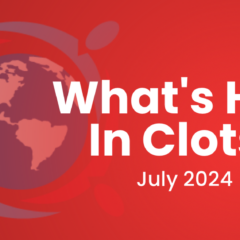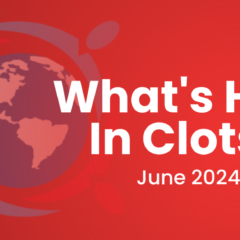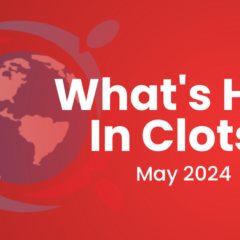Last updated on
Clot Chronicles: Preventing VTE in Outpatients with Cancer
Hello, I’m Dr. Chris Holmes, an associate professor at the University of Vermont and Acting Director of the Division of Hematology and Oncology as well as Associate Director of the Thrombosis and Hemostasis Program.
Today on Clot Chronicles, we’re going to be focusing on the prevention of venous thromboembolism (VTE) in outpatients with cancer. Specifically, we’re going to focus on a guideline implementation model that was developed here, at the University of Vermont, and recently published in the journal JCO Oncology Practice. This is a multidisciplinary model that involves patients in decision-making and uses a validated risk assessment tool.
So, why develop the model? Well, we know that VTE is common in patients with cancer. And at least 70-80% of VTEs will occur in the outpatient setting. We also know that VTE is costly to the patient in terms of an increased risk of major bleeding, decreased quality of life, as well as an increased risk of death – but VTE is preventable. Based on prior historical studies, we know the efficacy of low-molecular-weight heparins, and the most recent studies in the AVERT and CASSINI trials point to the efficacy of DOACs in the outpatient setting as well.
We also know that guidelines currently recommend VTE risk assessment in all cancer outpatients initiating cancer-directed therapy, and that patients who are at high risk of VTE, which is currently defined as a Khorana risk score of 2 or greater, are considered for VTE prophylaxis. What we may not know, however, is that guidelines, in reality, are different. Based on data from the Association of Community Cancer Centers, as well as our own data here in Vermont, we know that only 14% of patients report being told about the risk of VTE by their provider. And importantly, only 5-9% of those patients receive a standardized VTE risk assessment.
It’s for that reason that we began work on our current Vermont Model. The model was based on identified barriers to guideline implementation. Those included an oncologist’s unfamiliarity with assessing and estimating bleeding risk, the multiple anticoagulant choices that are now available, as well as lack of familiarity with drug interactions and drug dosing. Importantly also, this is an overwhelming time for patients, and also a time when the oncologists need to focus not only on the new therapy to deliver, but on other supportive care measures as well.
So, we developed this VTEPACC model, which stands for Venous ThromboEmbolism Prevention in the Ambulatory Cancer Clinic. This became known as the Vermont Model. In the Vermont Model, all cancer outpatients who are initiating therapy receive a thrombosis risk assessment. Importantly, we immediately begin to incorporate our multidisciplinary team and a risk assessment is done by our nursing colleagues. It’s embedded in an EHR workflow sheet and filled out by our nursing team.
In addition, our nurses play a key role in VTE education for all of our patients, and high-risk patients are then referred to the Thrombosis and Hemostasis Program. On referral, the pharmacist becomes involved and looks at drug interactions (or potential drug interactions), including chemotherapy, that may increase the risk of developing thrombocytopenia. The patient then meets with the thrombosis and hemostasis expert and anticoagulation recommendations are made. Then, an individual care plan is developed for the patient with patient decision-making and input.
So, what are the outcomes of a multidisciplinary team approach to preventing VTE? Well we were able to increase VTE education and risk assessment rates from less than 5% to 95% and sustain that over 2 years – and the program continues today.
We were able to reduce the risk of VTE by 50% in our high-risk patients. And importantly, over 90% of patients who were referred to the Thrombosis and Hemostasis Program actually accepted the referral and interacted with the thrombosis and hemostasis specialist.
So, the key takeaways points then are that the VTEPACC Model is one that can be used to achieve guideline implementation. It’s based on a multidisciplinary team approach. It has the patient involved in decision-making, and it involves individualized assessment of both bleeding and thrombosis risk. Key to its success is that it is importantly embedded into clinical practice—and into the oncology clinical practice—and at the same time, it maximizes local hematology expertise.
Our goal here at the University of Vermont is to raise the importance of VTE prevention and education to that of neutropenic fever prevention and education, a concept that is so firmly embedded in our care team. We are now moving this VTEPACC program into rural and community practices to assess its feasibility as well. We’d also like to extend an invitation to those interested in the model to reach out as we continue to refine the model, involve new sites in the research setting, and offer support to those who would like to implement the VTPACC Model using our recently developed VTEPACC toolkit in their own practice setting. Finally, I’d like to thank my team at the University of Vermont, as well, for their continued support and, importantly, the multidisciplinary team support. Thank you.



